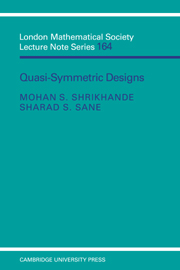Book contents
- Frontmatter
- Contents
- Preface
- Acknowledgments
- I Basic results from designs
- II Strongly regular graphs and partial geometries
- III Basic results on quasi-symmetric designs
- IV Some configurations related to strongly regular graphs and quasi-symmetric designs
- V Strongly regular graphs with strongly regular decompositions
- VI The Witt designs
- VII Extensions of symmetric designs
- VIII Quasi-symmetric 2-designs
- IX Towards a classification of quasi-symmetric 3-designs
- X Codes and quasi-symmetric designs
- References
- Index
IX - Towards a classification of quasi-symmetric 3-designs
Published online by Cambridge University Press: 05 May 2010
- Frontmatter
- Contents
- Preface
- Acknowledgments
- I Basic results from designs
- II Strongly regular graphs and partial geometries
- III Basic results on quasi-symmetric designs
- IV Some configurations related to strongly regular graphs and quasi-symmetric designs
- V Strongly regular graphs with strongly regular decompositions
- VI The Witt designs
- VII Extensions of symmetric designs
- VIII Quasi-symmetric 2-designs
- IX Towards a classification of quasi-symmetric 3-designs
- X Codes and quasi-symmetric designs
- References
- Index
Summary
All through the development of this monograph up to the present point (especially Chapters V through VIII), we have looked at various properties and characterizations, both parametric and geometric, of quasi-symmetric designs, essentially to the point of convincing ourselves that the problem of determination of all the quasi-symmetric designs is indeed a hard problem. With that background, this chapter will show us that the situation for quasi-symmetric 3-designs is more promising. This is to be expected since a derived design of a q.s. 3-design at any point is also quasi-symmetric and that gives us more information (Example 5.24). However, quite unlike the case of q.s. 2-designs, very few q.s. 3-designs seem to be known. In fact, up to complementation there are only three known examples of q.s. 3-designs with x ≠ 0. Application of the ‘polynomial method’ to this rather mysterious situation (see Cameron) is the theme of the present chapter.
Cameron's Theorem (Theorem 1.29) has been one of the focal points of our study of q.s. designs. This is more so for q.s. 3-designs since the extensions of symmetric designs obtained in that theorem are in fact quasi-symmetric with x = 0 (and conversely). Despite its completeness, the classification given by Cameron's theorem is perhaps and unfortunately only parametric as revealed in the following discussion. A Hadamard 3-design exists if and only if a Hadamard matrix of the corresponding order exists. Hadamard matrices are conjectured to exist for every conceivable (i.e., a multiple of four) order.
- Type
- Chapter
- Information
- Quasi-symmetric Designs , pp. 174 - 191Publisher: Cambridge University PressPrint publication year: 1991



